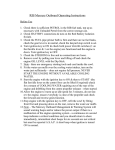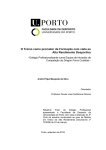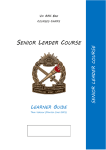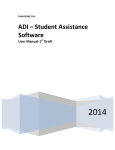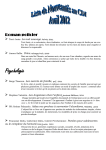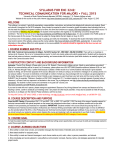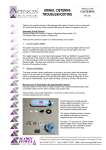Download User Guide - Coastal FC
Transcript
Coach's Toolkit Training Sessions and Game Day Outdoor July 2015 Copyright Copyright© 2015 Coastal Football Club. Contents Copyright 0 Contents i About this toolkit 1 The role of the coach 2 Principles of Play 3 Training plan 5 Game plan 7 Training Sessions 10 Dribbling (with standard warm-up and small-sided game) 11 Turning and changing direction 20 Passing 25 Shooting 30 Running 35 Attacking: 1 vs 1 40 Attacking: 2 vs 1 45 Coach’s cheat sheet: Training sessions 50 i Coach's Toolkit About this toolkit This toolkit has been designed to provide coaches a structured guideline in the development of club players and program management. It will serve as a technical and managerial resource to provide coaches with basic knowledge that will assist in the delivery of an excellent player development environment. In an effort to provide a consistent model for player development and program management across Coastal FC, we have adopted the Canadian Soccer Association’s (CSA) Long-Term Player Development (LTPD) pathway. The overall objective of our program is to foster and encourage sportsmanship, education, skill development, and respect for teammates, opponents and referees in a fun, supportive and player-centered environment. Soccer at Coastal FC should be a fun and positive experience for everyone. Your overall goal as a Coastal FC coach is to create the above environment and monitor the development and enjoyment of each player under your charge. This toolkit will help you accomplish this. Thank you for being a coach and good luck in the season ahead! Regards, Mark McQueen Coastal FC Technical Director About this toolkit 1 Coach's Toolkit The role of the coach Teacher Different hats. Soccer coaches wear many different hats, particularly when they’re training Mentor Role model young players, many of whom are lacing up their cleats for the first time. You might find yourself leading a fun activity one minute and reining in a Cheerleader distracted player the next. Parent Flexible. You must be flexible, because a session or drill that was meant to last ten minutes Occasional disciplinarian might need to be switched up after half that time to keep the players engaged. Have fun. Above all, make sure everyone is enjoying themselves—including you! Demanding and rewarding. Being a coach is demanding, but it’s also incredibly rewarding. There’s nothing quite like witnessing the thrill a young player gets when they score their first goal or save a goal. And the lessons a child learns from a good coach can last a lifetime. Develop good people. The objective isn’t just to develop better soccer players—it’s to develop well-rounded people who are disciplined, persistent and able to work well with others. Tremendous responsibility. Shaping the lives of young people is a tremendous responsibility. As a coach, you must do everything you can to foster a player’s love for the game, and to help them achieve their potential. Be enthusiastic and let your personality come out. Good coaches seek out new ways to develop their knowledge of the game and how players learn. This toolkit is designed to get you started. But it’s not just about what you teach. It’s about how you teach. Ultimately, it’s your personality and enthusiasm that will have the biggest impact on your players. The role of the coach 2 Coach's Toolkit Principles of Play Why are they important? The principles of play are: l Fundamental to effective football and successful team play. l The same for most team sports. l The foundation for teaching the game. l Along with good technique, essential to enabling your players to play any system and style as determined by the coach. What are they? Attack Disperse (aka Dispersal). Players must spread out front to back and side to side in Defend Delay. The defender nearest the player with the ball must close down the space to delay shootorder to stretch and pull defenders out of posing, forward passing, and dribbling opportunities. ition. Support. Players must take up good supporting positions close to the ball and away from it where they can receive the ball without it being intercepted. Need support in front, to the side and behind the ball. Penetrate (aka Penetration). Players must decide whether to advance the ball—by dribbling, passing around, over, or between opposing players— or shoot to score. Move (aka Mobility). To create space and Cover (aka Depth). To support the defender nearest the ball, other defenders must reduce forward passing opportunities by covering space and marking players. Block (aka Compactness). Players must defend as a block and restrict space between defenders from front to back and side to side, making it difficult for opposing players to find space or play penetrating passes. Balance. Players must seal off dangerous open- unbalance defences, players must make cal- ings away from the ball to limit the opponents culated moves and change positions to move attacking options. Usually it is the players away Principles of Play 3 Coach's Toolkit Attack and stretch the defence. Defend from the ball—the third defenders—who maintain the defence's balanced formation. Control. Players individually and collectively Improvise (aka Improvisation). To unlock must be patient and wait for the correct moment tight defences, occasionally players need to to win the ball back and not be drawn too far out do the unexpected. of position and create an opening for a scoring opportunity. Principles of Play 4 Coach's Toolkit Training plan Training plan Pre-training routine Understand the session drills. You need to know the drills quite well because there isn’t much time to look them up when you are on the field and when the players are getting restless waiting for instructions. Dress like a coach. If you look like a coach, the players may show you more respect and it will give you some confidence as a coach. Arrive early and get setup. If you don’t arrive early or on time you will find yourself always running behind which will take away from the training session experience for the players and you. In-training routine Be organized. Being familiar with the session and arriving early will help to get you off to a good start. Having the training material handy will help you stay organized and give you one less thing to think about in case you need to check something or make an adjustment to keep the players interested. Be enthusiastic. Ultimately, it’s your personality and enthusiasm that will have the biggest impact on your players. You obviously enjoy soccer or you wouldn’t have become a coach, so don’t be afraid to show your love for the game and for the players you are coaching. Be positive. You are going to help players more by staying positive and looking for good things that a player has done than criticizing a player for making a bad play. Be loud. To get and keep the players attention and to make sure they hear your instructions, use a firm, clear, and loud voice. Coaching methodology Stop. To deliver a teaching point using one of the teaching techniques— Command, Question and Answer, and Guided Discovery—you need to stop the activity and get all the players’ attention. Demonstrate. Most people learn best if they can see what it looks like. Rehearse. Let the players try, to make sure they understand before you go live. “Go live.” Once you can see that they understand, restart the activity. Training session plan Standard warm-up. The warm-up is to get the players (and coach) Training plan 5 Coach's Toolkit Training plan...Cont'd moving and loose and to practice the important skill of dribbling. The standard warm-up is used at the beginning of every training session. Time: 5 to 10 minutes. Technique. In this section a new soccer technique is introduced and practiced. Time: 10 to 12 minutes. Skill. In this section, pressure in the form of a defender is added to further develop the skill. Time: 10 to 12 minutes. Small-sided game: Switch. The game is an opportunity to try out the new technique and to just have some fun. The small-sided game is used at the end of every training session. Time: 15 to 25 minutes. Post-training routine Key points. Reinforce key points of session. Remind the players what was worked on. Went well. Discuss what the players did well in the training. Needs improvement. Outline areas of improvement. Try to avoid singling out individual players in team discussions. Instead talk to the players one-on-one. Clean up space. Remove your cones, balls, clothing, water bottles and so on to allow the next team to setup and start their training session. The following training sessions are included in this toolkit: Dribbling Turning and Changing Direction Passing Shooting Running Attacking: 1 vs 1 Attacking: 2 vs 1 Training plan 6 Coach's Toolkit Game plan Game day plan Pre-game: Coach preparation and warm-up Arrive early. Arrive at least 20 minutes before kick-off to setup and greet players as they arrive. Setup and start warm-up. With help from assistant coach, setup the cones and goals for the warm-up activity and get players warming up. Have assistant coach oversee warm-up. Time: 5 minutes. Check in with other team. Check in with other team’s coach to decide who is wearing pinnies, game start time, substitution procedure, and so on. Setup and start technical drill. Setup the technical drill. Time: 5 to 10 minutes. Check players’ equipment. Check players’ equipment and uniform and ask them how they are doing. Conduct team talk. Allow at least 5 minutes before the start of the game to have a little talk and to let players rest. Pre-game: Team talk Formation and starting positions. For the more experienced or older players, explain the formation and their starting positions. Reinforce: What to do in attack. On the attack, spread out—forward and back, and side to side—in order to stretch and pull defenders out of position. What to do in defence. Compete for the ball, be strong in tackling to increase chance of getting ball and to reduce chance of injury, chase other team back towards their goal, get on goal side (inside) of opponent. Decision making: Dribble or pass. First of all, don’t be afraid to dribble with the ball. Dribble: a) when there is open space around you and there is an opportunity to move the ball closer to the opponent’s goal, b) to keep the ball away from your opponent, and c) to get in a better position to pass or shoot the ball. Pass: a) when your teammate is in a better position to advance the ball or score, b) to get around a defender, c) to keep ball away from opponent. Never run away from a pass. Always move to the ball as it’s played Game plan 7 Coach's Toolkit Game day plan...Cont'd to you. Otherwise alert defenders will beat you to it. Forming shapes. For the more experienced or older players, form triangles and diamonds to open up passing lanes. Passing ball sideways and backwards. If you can’t go forward, there is nothing wrong with passing sideways or backwards. Make sure the other team can’t get the pass. Moving to open space. The most important thing for any player to keep in mind is that they must make themselves available for a pass by ensuring a clear passing lane between themselves and the ball carrier. Doing this ensures the player with the ball will always have an option if they cannot move forward. Keeping head up and looking for pass. If you don’t look up when you are dribbling, you are not going to be able to find someone to pass to and will probably give up the ball. Working hard and not giving up. Yes, a cliche, but still worth mentioning. The teams who work the hardest and who don’t let minor setbacks get them off their game, are usually the most successful. Being creative. Try different things and don’t worrying about making mistakes. A player who tries something new and fails is going to be more successful than a player that doesn’t take any chances. Having fun. Of course, that’s what it’s all about. During game Don’t coach players with ball. Coach players who are near or away from the ball, rather than the player with the ball. Avoid telling the players what to do when they receive the ball. Allow the players to play and make their own decisions with the ball. Support players with respect to their positioning.Where time permits, use the Question and Answer teaching technique to get players to learn how to get into position. Help players stay composed. Help players learn to maintain and hold their composure when they receive negative comments from the sidelines or they have a dispute with an opponent or official. Communicate with assistant coaches. Communicate with the other coaches to ensure your messages are consistent in content and with the above recommendations. Manage sideline players. Ensure players on sidelines are watching game and encouraging their teammates and not goofing around, Game plan 8 Coach's Toolkit Game day plan...Cont'd being negative or interfering with the play. Halftime Going well. Identify what is going well and ask players to give their thoughts on the game so far. Needs improvement. Identify what can be improved, individually and collectively, and discuss how to fix. Try to avoid singling out individual players in team discussions. Instead talk to the players oneon-one. Players health, attitude and behaviour. Ensure players are getting hydrated and nourished, staying positive, and not goofying around. Post-game: Team talk Went well. Identify what went well and ask players to give their thoughts on the game. Needs improvement. Identify what can be improved and discuss how to fix for next game. Try to avoid singling out individual players in team discussions. Instead talk to the players one-on-one. Hydrate and get dressed. Encourage the players to hydrate and change or add clothes. Positive departing message. Send players away with a positive message (e.g., ”keep up the good work” or “we are getting very close”), and emphasize the importance of practicing at home and school, and remind them of the next practice. Game plan 9 Training Sessions 10 Dribbling (with standard warm-up and small-sided game) 11 Coach's Toolkit Standard warm-up: Dribbling in a box (5–10 min/hr) Purpose This warm-up drill should be used at the beginning of all the sessions, including this session. This warm-up is designed to: l Start the practice with some light activity for the players. l Improve the player’s skill handling the ball. Field setup and video Place cones to form a rectangular-box shape. The box should be big enough to gives players room to move but not too big that the players cannot see each other or they cannot hear your calls. A rule of thumb is 2 yards per player in short direction and 3 yards per player in long direction, rounded up to nearest five. For example with 10 players, create a box approximately 20 by 30 yards. This box will be used for the entire training session. Instructions Balls: One per player. Player dribbles ball around within box using all sides of both feet and then does one of the following moves called out by the coach for a few seconds. Then coach calls out to dribble before calling next move. l Toe tap. Player quickly taps bottom of toes on top of ball alternating between right and left foot. Dribbling (with standard warm-up and small-sided game) 12 Coach's Toolkit l Shuffle. Player passes ball between the feet while lifting legs and jumping slightly. l Step over. Without moving the ball the player steps over ball to the right with the right foot and then steps over the ball to the left with the left foot. l Circle right or left with inside of foot. Using the inside of one foot, the player moves the ball clockwise with left foot or counterclockwise with right foot. l Circle right or left with outside of foot. Using the outside of one foot, the player moves the ball clockwise with right foot or counterclockwise with left foot. l Roll ball. Standing behind or beside the ball, the player rolls the ball forward, left or right using the bottom of foot. l Pullback. Player dribbles ball forward a couple of steps and then pulls the ball back with bottom of right foot while turning 180 degrees. Player then dribbles a couple of steps and pulls ball back with bottom of left foot while turning 180 degrees. l Shield ball. Using a combination of the circle left or right and the pullback with right foot or left, player moves forward and back in a half circle to shield the ball from a pretend opponent. Leave it up to the player, but the player should be encouraged to use the weaker foot an equal amount of time as the stronger foot. Options To add some fun to the drill, get the players to count the number of times they do each move and have them call out their score to create a bit of competition. Coaching points Encourage the players to: l Keep the ball close to maintain control. l Move as quickly as possible. l Keep their head up as much as possible. l When applicable, use both feet and use both sides of the foot. Dribbling (with standard warm-up and small-sided game) 13 Coach's Toolkit Technique: Dribbling using gates (10–12 min/hr) Purpose These drills help to further develop players dribbling skills using gates to represent opposing players. Field setup and video Keep the cones and size of box from the warm-up and use the remaining cones to create gates for the players to dribble through. Place the cones in groups of two, 2 to 3 feet apart throughout the inside of the box. Make the gates wider for the younger players compared to the older, more-skilled players. Instructions and coaching points Dribbling using gates Name Instructions Coaching points l Change speeds to surprise opponent. l Quick bursts of speed through the gates. l Keep the ball close to maintain control. l Keep their head up as much as possible. 1. Have the players count as they Dribble through gate dribble through as many gates as they can in 20 to 30 seconds. 2. Repeat and try to beat their l score. l Use both feet and use both sides of the foot. Be creative by trying different moves to get through gate and move to next gate. Dribbling (with standard warm-up and small-sided game) 14 Coach's Toolkit Dribbling using gates...Cont'd Name Instructions Coaching points 1. Have the players count as they pass the ball through as many gates as they can while they run around the gate. Pass through gate 2. The players should count how l Use inside of foot to pass ball through. l Quick burst of speed around the gate. l many gates they pass through in 1 minute. l Use appropriate weight and accuracy on pass. Use both feet. 3. Repeat and try to beat their previous score. 1. Have players approach gates Pass down side of gate lengthwise and pass the ball down one side (past 2 cones) and run around the other side. For example, if they pass the ball down the right side using the inside of the right foot then they run down the left side to meet the ball. l l l 2. The players should count how Use left foot to pass down the left side of the cones and right foot to pass down the right side. Use inside of foot to pass the ball. Use appropriate weight and accuracy on pass. many gates they pass through in 1 minute. 3. Repeat and try to beat their previous score. Dribbling (with standard warm-up and small-sided game) 15 Coach's Toolkit Skill: Dribbling thru gates 1 vs 1(10–12 min/hr) Purpose The purpose of the skill drill is to further develop the skill of dribbling by introducing a defender. Field setup and video Same setup as for Technique. Instructions Balls: Each offensive player has a ball. 1. Have half the players put on pinnies and each grab a ball. 2. Direct half the players with pinnies to one corner to line up in single file and the other half to line up in the next nearest corner. The players with pinnies will start as the offensive players. 3. Divide the other players in half and direct them to line up in single file in the two remaining corners. These players will start as defenders. 4. When you say “Go”, one offensive player from each line tries to dribble through as many gates on their side of the box as possible while the defensive player runs over and tries to take the ball away. 5. If the defender takes the ball away, they should try to dribble through as many gates as possible while the other player tries to take the ball back. 6. Allow players about 15 to 20 seconds and then return to their lines while the next four play- Dribbling (with standard warm-up and small-sided game) 16 Coach's Toolkit ers go. 7. After three rotations, have the players without pinnies start with the ball for three times. Coaching points l Keep the ball close to maintain control. l Keep their head up as much as possible. l Shield the ball from the defender. l Encourage the defender to close down the space and pressure as fast as possible. Dribbling (with standard warm-up and small-sided game) 17 Coach's Toolkit Small-sided game: Switch (20–25 min/hr) Purpose The purposes of the small-sided games are to: l Let the players have some fun. Most players prefer to play a game to doing drills. l Give the players an opportunity to practice what they have learned. l Get the players ready to play a real game against another team. Field setup and video Remove any cones from inside the box and convert or make sure the end lines have three goals. Instructions Balls: Coach keeps and feeds in balls one in at a time. 1. Divide the players into two teams and have one team put on the pinnies. 2. Divide each team into two groups. 3. For each team, have half the team move into positions inside the playing field and the other half line up along their end line. 4. On “Go!”, have one team start with the ball and try to get the ball into the other team’s goal. 5. At appropriate intervals, such as when a goal is scored or the ball goes off the side, tell the players to switch. On “Switch”, the inside players move to the end line and the end line Dribbling (with standard warm-up and small-sided game) 18 Coach's Toolkit players move into the field. When necessary, to keep the game moving, the coach feeds new ball in to restart game. 6. On restarts, use “Go!” and defenders can’t move until the first pass is received. Coaching points l Help the players make the right decision on when to dribble, pass, and change direction. l This is where the following teaching techniques, discussed in the Teaching techniques topic, are used most: Direct command; Question and answer; Guided discovery. l Let the players play to get a flow going and give them a feel for a game situation, but look for opportunities to stop the play and teach them what they did wrong or right using one of the teaching techniques. Dribbling (with standard warm-up and small-sided game) 19 Turning and changing direction 20 Coach's Toolkit Technique: Turning (10–12 min/hr) Purpose This drill will help develop the technique of turning with the ball using a number of different moves. Field setup and video Setup a line of cones approximately 8 yards from the side where the players will line up. Instructions Balls: One for each group of two players. 1. Have the players chose a partner and line up in single file with partner and one ball along the touch line. Have the groups spread out along the touch line. 2. First player in line dribbles out to the cone line, does a turn, and then passes the ball back to their partner. Turns can be any of the following: l Turn using inside of foot. l Turn using outside of foot. l Pullback or drag back. For more experienced players: l Cruyff turn. Fake the pass or shot and turn the ball back with the inside of the toe of the same foot. Turning and changing direction 21 Coach's Toolkit l Step-over turn. Step over the ball, turn body back in opposite direction of step-over and touch the ball back with the inside of the opposite foot. Coaching points l Always keep the ball moving. l Turn with the ball so you can always see it. l Encourage use of both feet. l Progress to emphasize quickness and consistency. Turning and changing direction 22 Coach's Toolkit Skill: 1 vs 1 with 4 goals (10–12 min/hr) Purpose The purpose of the skill drill is to further develop the skill of turning and changing direction by introducing a defender. Field setup and video Remove the inside cones from the Technique session and setup a mini grid using just half the field with two goals per side in the corners and a cone at each end in the centre between the goals. Instructions Balls: Coach keeps balls and feeds in one at a time. 1. Divide the players into two teams and have one team put on the pinnies. 2. Have one team line up in single file in the centre between the goals on one side and the other team line up in the centre between the goals on the other side. 3. The coach passes the ball in from the side to either one of the players at the start of the lines. 4. The player with the ball tries to dribble through one of the goals of the other team while the defender tries to take the ball away. 5. If the defender takes the ball away, they should try to dribble through the opponent’s goal. Turning and changing direction 23 Coach's Toolkit Option: If you want to match up the players by skill level, give the players from opposing teams the same number and then call out a number. Coaching points l Encourage the players to use turns and quick changes of direction to get past the defender. l Encourage the players to control the ball when they first get it. Turning and changing direction 24 Passing 25 Coach's Toolkit Technique: Pass and follow (10–12 min/hr) Purpose The purpose of this drill is to work on the fundamentals of making a good pass to a teammate and on controlling the ball when receiving a pass. Field setup and video Add a row of cones near the centre and adjust the cones on one end to create three or four passing lanes for this drill. One lane per minimum of three players. Instructions Balls: One ball per group. 1. Divide players into groups of three or four. 2. Assign the groups a lane. 3. Have the groups line-up with two at one end of the lane and the remaining group members at the other end of the lane. 4. The player with the ball dribbles a couple of steps and then passes to the player at the end of their lane. 5. The player who passes the ball, follows the ball and then runs to the end of the other line. 6. The player receiving the pass, controls the pass, dribbles a few steps and then passes to the player at the end of their lane. Passing 26 Coach's Toolkit Options: For the more experienced players, try: l One touch to control and one touch to pass. l Short–short–long with groups of four: 1. Player with ball passes to player beside them. 2. Player passes back. 3. Player passes down the lane to one of the other two players. 4. Passing players move back to receive pass from other side. Coaching points l Always on toes ready to receive the ball. l Contact the centre of the ball with the centre of the inside of the foot. l Firm, accurate, and on the ground passes. l Receive with inside of foot. l Always keep the ball moving. l No stopping ball with bottom of foot (exception: U5/6). l Use both feet. l For short-short-long passing: l Angle of passing and receiving. l Play leading passes. l Body positioning. Passing 27 Coach's Toolkit Skill: 2 vs 2 (10–12 min/hr) Purpose To further develop the skill of passing by introducing pressure with defenders. Field setup and video Similar setup as for Technique except make sure there is a goal on each end of the mini field, as indicated below. Instructions Balls: Coach keeps balls and feeds in one at a time. 1. Divide the players into two teams and have one team put on the pinnies. 2. Have half the players from team 1 line up in one corner in single file and the other half of the team line up in the nearest other corner. Do the same for team 2 and have them line up at other end in the corners. 3. You pass the ball to a player in one of the corners. 4. The player receiving the ball tries to pass to their teammate from the other corner and ultimately to score on the other team’s goal as the players from the other team try to take the ball away. 5. If the ball goes out or a goal is scored, players return to their corner to the back of the line. Coaching points l Control the ball when receiving the initial pass. Passing 28 Coach's Toolkit l Keep head up to make a decision to dribble or pass. l Don’t allow the players to just “boot” the ball. If they do, stop the play, and play the ball in again until they are successful at making at least one pass. Passing 29 Shooting 30 Coach's Toolkit Technique: Shooting on goal (10–12 min/hr) Purpose The purpose of this drill is to give the player an opportunity to work on the shooting technique. Field setup and video Setup additional cones along one end for dribbling through. Along the touch line, remove the cones until you reach the cone nearest the centre. Finally, make sure there are two cones together on the opposite touch line for a goal. The single cone near the centre on the touch line can also be brought in 5 yards closer to the goal. Instructions Balls: One per player. 1. Have all the players get a ball and line up in the corner behind the line of cones. 2. Each player dribbles their ball through the cones. 3. The next player can start as soon as the lead player is half way through the cones. 4. At the end of the cones, the player turns to the middle of the field and goes around the outside of the cone in the centre of the field. 5. The player dribbles a little closer to the goal before shooting the ball through the goal. 6. The player retrieves their ball and then runs to the end of the line. Coaching points l Use the laces for power when far away from the net and use the inside of the foot for accuracy when close to the net. Shooting 31 Coach's Toolkit l Encourage the use of the left foot when coming across from the right and the right foot when coming across from the left side. l Encourage one touch past the cone and then a shot. Shooting 32 Coach's Toolkit Skill: 1 vs 1 with 1 goal (10–12 min/hr) Purpose This drill encourages the player to setup and shoot more quickly by introducing a defender. Field setup and video Place one cone on each end line two-thirds of the way off the touch line. Instructions Balls: One team has one ball per player. 1. Divide players into two teams and ask one team to put on the pinnies. 2. Have each player from the pinnies side get a ball and line up single file in the corner beside the goal. 3. Have the other team, which will start as the defenders, line up single file in the other corner beside the goal. 4. On “Go!”, the player with the ball runs forward, around the cone, towards the goal and takes a shot on the goal. 5. At the same time the defender runs around their cone and then tries to stop the offensive player from taking a shot. 6. The offensive player retrieves the ball and runs to the end of their line. 7. After three rotations, have the players without pinnies start with the ball three times. Shooting 33 Coach's Toolkit Coaching points l Speed to the ball. l When they get the opportunity and see the net, take a shot. l Use the laces for power when far away from the net and use the inside of the foot for accuracy when close to the net. l Encourage the player without the ball to protect the net—“get goal side”—and stop the shot. Shooting 34 Running 35 Coach's Toolkit Technique: Running with ball (10–12 min/hr) Purpose The purpose of this drill is to help the players develop the skill of running with the ball. Field setup and video You should be able to use the setup from the warm-up as long as you have a cone two-thirds or three-quarters of the way done the side (touch) lines and three goals setup on the end line. Instructions Balls: One per player. 1. Divide the players into two teams and have one team put on pinnies. 2. Have each player get a ball. 3. Have one team line up in one corner on the end line in single file. 4. Have the other team line up on the same end in the other corner. 5. On “Go!”, have the first player in the line run with their ball to the second from last cone, go around the cone then run back on the other side with the ball and dribble or shoot the ball into the goal. 6. Player retrieves their ball and goes to end of the line while next players goes. Option: To create some competition and to get the players to move faster, turn it into a relay. Next player has to wait for shot to pass the goal line before going. Running 36 Coach's Toolkit Coaching points l Run at good pace with ball out in front, but not too far out in front. l Keep head up and remain in control of the ball. l Slow down if control is continually lost. Running 37 Coach's Toolkit Skill: 1 vs 1 running and shooting (10–12 min/hr) Purpose This drill further develops the skill of running with the ball and shooting by introducing a defender. Field setup and video Same setup as for Technique. Instructions Balls: All players on one team have a ball. 1. Similar to Technique, have pinnies line up in single file in the corner on the end line to the right of the centre goal. 2. Have the other team line up in the corner on the other side of the goal. 3. On “Go!”, the first player in the line runs with the ball, goes around the second from last cone and then runs in with the ball and takes a shot on the goal. 4. At the same time, the defender runs up and around the second from last cone and then tries to take the ball away or block the shot. 5. The player who started with the ball retrieves the ball and goes to the end of their line. 6. After three rotations, switch and have the non-pinnies move to the line with the balls. Coaching points l Run with ball and keep it out of feet. l Keep head up and be aware of where defender is at all times. Running 38 Coach's Toolkit l Keep ball within playing distance. l Get shot away before defender applies pressure. Running 39 Attacking: 1 vs 1 40 Coach's Toolkit Technique(10–12 min/hr) Purpose This drill works on making sharp right and left cuts with the ball to develop a technique for moving past a defender. Field setup and video At one end of the field, in two or three lines place three cones 3 to 4 yards apart starting 5 yards from the end. Instructions Balls: One per player. 1. Divide the players into groups equal to the number of rows you have setup. 2. Have each player get a ball and line up with their group on the end line behind one of the lines of cones. 3. On “Go!”, the first player dribbles in and out of the cones with sharp cuts at the cones to make a figure 8 and then turns and goes back through the cones with the same moves. 4. Player then moves to back of the line. Option To add some fun and to get the players to move faster, turn it into a race. Attacking: 1 vs 1 41 Coach's Toolkit Coaching points l Keep tight control and playing distance with ball. l Keep head up. l Make sharp cuts with the ball with light touches when dribbling. l Slow down if control is continually lost. Attacking: 1 vs 1 42 Coach's Toolkit Skill (10–12 min/hr) Purpose This drill helps to further develop the skill of dribbling past a single defender. Field setup and video Setup two goals at each end approximately 5 yards in from the end line. Also place a cone in the middle of both ends for the players to line up behind. Instructions Balls: Coach keeps and feeds in balls one at a time. 1. Have half the players put on pinnies and line up in single file at one end behind centre cone. 2. Have the other players line up the same way at the other end. 3. On “Go!”, the coach passes a ball to the first player in one of the lines. 4. The player must try to dribble past the defender and dribble (not shoot) through the defender’s goal while the defender runs over and tries to take the ball away. 5. If the defender takes the ball away, they should try to dribble and score. 6. When the coach says “Next!”, the ball is returned to the coach, a new ball is passed in by the coach, and the players move to the end of their respective lines. Option: To add some fun, keep score. Attacking: 1 vs 1 43 Coach's Toolkit Coaching points l Dribble ball at good pace using inside and outside of both feet. l Maintain tight control and playing distance with the ball. l Keep head up and remain in control of the ball by making light touches on the ball. l Slow down if control is continually lost. l Try to unbalance and beat defender by using cuts, fakes, and change of pace. Attacking: 1 vs 1 44 Attacking: 2 vs 1 45 Coach's Toolkit Technique (10–12 min/hr) Purpose The purpose of this drill is to develop the technique of performing a give-and-go pass with a teammate. Field setup and video Setup three cones in a triangle approximately 5 yards apart at one end of the field and a goal at the other end. Instructions Balls: All balls with the group lining up nearest the end line. 1. Divide players into two groups and have group 1 line up on the left side of the triangle and group 2 line up on the top side. 2. Move all the balls to group 1. 3. On “Go!”, the first player in group 1 makes a pass to the first player in group 2 and runs towards the goal for return pass. 4. The group 2 player receiving the pass controls the ball and then makes a lead pass to the group 1 player. 5. The group 1 player receives the pass and dribble or makes a light shot through the goal. 6. The group 2 player then moves to the back of the group 1 line. 7. The group 1 player retrieves the ball, dribbles around the outside of the field, gives the ball back to group 1, and then moves to the end of the group 2 line. Attacking: 2 vs 1 46 Coach's Toolkit Option: To add some fun, have the players keep track of the number of goals they score. Coaching points l Pass ball to feet for first pass, and to space for second pass. l Make contact with centre of ball, and use appropriate weight and accuracy for each pass. l Player receiving first pass can start by taking two touches (i.e., control and then pass) but try to progress to one touch. Attacking: 2 vs 1 47 Coach's Toolkit Skill (10–12 min/hr) Purpose This drill continues the work on developing the skill of making a give-and-go pass by introducing a defender. Field setup and video Remove the cone triangle and add a goal to the end without a goal. Instructions Balls: Coach keeps and feeds in the balls one at a time. 1. Have group 1 or 2 from the Technique drill put on pinnies and have half the group line up in one corner beside a goal and the other half line up in the other corner beside the same goal. 2. Have group 2 line up in the far corner. 3. On “Go!”, the coach passes across the field to the group 1 player while the other group 1 player runs forward waiting for a pass and as the defender from group 2 tries to take the ball away from passer. 4. The objective is to complete a give-and-go pass or other pass around the defender and score a goal. 5. If a goal is scored or the coach says “Next!”, the ball is returned to the coach and the group 1 players move to the other group 1 line and the group 2 player moves to the back of the group 2 line. Attacking: 2 vs 1 48 Coach's Toolkit 6. After three rotations, have the group 2 players switch with the group 1 players and start with the ball three times. Coaching points l The ball carrier should attack space and decide when to dribble or when to pass. l The supporting player should provide good angle and distance of support to ball carrier. l Use give-and-gos and/or overlapping runs to move ball past defender and create scoring opportunity. Attacking: 2 vs 1 49 Coach’s cheat sheet: Training sessions 50 Coach's cheat sheet: Training sessions Warm-up Technique Skill: 1 vs 1 thru gates Small-sided Game (5–10 min/hr) (10–12 min/hr) (10–12 min/hr) (25 min/hr) Instructions. (One ball per player.)Player dribbles ball within box using all sides of both feet and then does one of the following moves called out by coach: toe tap; shuffle; step over; circle right or left with inside of foot; circle right or left with outside of foot; roll ball; pullback; shield ball. Options. a) Players count number of times they do each move and call out score to create competition, b) Give a code to moves with the longer names to make the players think a bit (e.g., CRO pron. “crow”). Instructions. (One ball per player.)Dribble thru: 1.Players count as they dribble through as many gates as they can in 20–30 secs. 2.Repeat and try to beat their score.Pass thru: 1.Players count as they pass ball thru as many gates as they can while they run around gate. 2.Players count gates in 1 min. 3.Repeat and try to beat score.Pass down side: 1.Players approach gates lengthwise and pass ball down one side (past 2 cones) and run around the other side. 2.Players count gates in 1 min. 3.Repeat and try to beat score. Same field as Technique. Remove inside cones from field. Three goals at each end. Instructions. (Each offensive player has ball.)1.Half the players put on pinnies and grab ball.2.Pinnies go to one corner and line up. Other half go to next nearest corner. Pinnies start as offense. 3.Divide other players in half and line up in two remaining corners as defenders. 4.On “Go”, one offensive player from each line dribbles thru as many gates on their side of the box as possible while defensive player runs over and tries to take ball away. 5.If defender takes ball away, dribble thru as many gates as possible while other player tries to take ball back. 6.Allow players 15–20 secs and then return to their lines while next four go. 7.After three rotations, have players without pinnies start with ball. Instructions. (Coach keeps and feeds in balls one at a time.)1.Divide players into two teams (one with pinnies). 2.Divide each team into two groups.3.For each team, have half the team move into positions inside the playing field and the other half line up along their end line. 4.On “Go!”, have one team start with ball and try to get the ball into the other team’s goals. Defenders can’t move until first pass is received.5.At appropriate intervals, such as when a goal is scored or ball goes off the side, tell players to switch. On “Switch”, the inside players move to the end line and end line players move into field. To keep game moving, coach feeds new ball in to restart game. Coaching points l l l l Keep the ball close to maintain control. Move as quickly as possible. Keep head up as much as possible. When applicable, use both feet and use both sides of the foot. l l l l l l Change speeds to surprise the opponent. Keep the ball close to maintain control. Keep head up as much as possible. Use both feet. Use inside of foot to pass the ball. Use appropriate weight and accuracy on pass. Technique Instructions. (1 ball/2 players) 1.Players choose partner 2. Line up single file with partner and ball on touch line and spread out. 3. First player dribbles to cones, does a turn, passes back. Turns: Inside of foot; Outside of foot; Pullback or drag back. Experienced players: Cruyff turn; Stepover turn. l l l l Keep the ball close to maintain control. Keep their head up as much as possible. Shield the ball from the defender. Encourage the defender to close down the space and pressure as fast as possible. l Skill (10–12 min/hr) Help players make right decision on when to dribble, pass, and change direction. Let players play to get a flow going, but look for opportunities to stop play and teach them what they did wrong or right using one of the following teaching techniques: Direct command; Question and answer; Guided discovery. l (10–12 min/hr) Instructions. (Coach keeps balls and feeds one in at a time).1.Divide players into 2 teams (one pinnies). 2. One team lines up in centre between goals. Other team opposite side. 3.Coach passes ball in to either player. 4.Player tries to move past defender, using turns, and dribble through goal. 5.If defender takes ball away, should try to dribble through goal. Option: Match players by skill level, give them number, and then call out a number. Coaching points l l l l Always keep the ball moving. Turn with the ball so you can always see it. Encourage use of both feet. Progress to emphasize quickness and consistency. Technique Instructions. (One ball per player.) 1.Have all players get a ball and line up behind line of cones. 2.Each player dribbles ball thru cones. 3.Next player can start as soon as lead player is half way thru. 4.At end of cones, player turns to middle of field and goes around outside of cone in centre of field. 5.Player dribbles closer to goal before shooting at goal. 6.Player retrieves ball and runs to end of line. l l Encourage the players to use turns and quick changes of direction to get past the defender. Encourage the players to control the ball when they first get it. Skill (10–12 min/hr) (10–12 min/hr) Coaching points l l l Use the laces for power when far away from the net and use the inside of the foot for accuracy when close to the net. Encourage the use of the left foot when coming across from the right and the right foot when coming across from the left side. Encourage one touch past the cone and then a shot. Command l l l l Speed to the ball. When they get the opportunity and see the net, take a shot. Use the laces for power when far away from the net and use the inside of the foot for accuracy when close to the net. Encourage the player without the ball to protect the net—“get goal side”—and stop the shot. Question and Answer Instructions. One team has one ball per player. 1.Divide players into two teams (one with pinnies). 2.Pinnies each get ball and line up in corner beside goal. 3.Other team (defenders), line up in other corner beside goal. 4.On “Go!”, player with ball runs forward, around cone , towards goal, takes a shot on goal. 5.At same time, defender runs around their cone and tries to stop player from taking shot. 6. Offensive player retrieves ball and runs to end of line. 7.After three rotations, non-pinnies start with ball. Guided Discovery Coach's cheat sheet: Training sessions Technique Instructions. (One ball per group.) 1.Divide players into groups of 3/4. 2.Assign groups a lane. 3.Groups line-up with two at one end of lane and the remaining at other end. 4.Player with ball dribbles couple of steps and then passes to player at other end. 5.Player who passes, follows ball and runs to end of other line. 6.Player receiving pass, controls pass, dribbles a few steps and passes to player at other end.Options. For the more experienced players, try: a)One touch to control and one touch to pass. b) Short–short–long with groups of four: 1.Player with ball passes to player beside them. 2.Player passes back. 3. Player passes down the lane to one of the other two players. 4.Passing players move back to receive pass. l l l l l l l Always on toes ready to receive the ball. Contact the center of the ball with the center of the inside of the foot. Firm, accurate, and on the ground passes. Receive with inside of foot. Always keep the ball moving. No stopping ball with bottom of foot (exception: U5/6). Use both feet. For short-short-long passing: l Angle of passing and receiving. l Play leading passes. l Body positioning. l l l Control the ball when receiving the initial pass. Keep head up to make a decision to dribble or pass. Don’t allow the players to just “boot” the ball. If they do, stop the play, and play the ball in again until they are successful at making at least one pass. Coaching points l l l Run with ball out in front, but not too far out in front. Keep head up and remain in control of the ball. Slow down if control is continually lost. l l l l Run with ball and keep it out of feet. Keep head up and be aware of where defender is at all times. Keep ball within playing distance. Get shot away before defender applies pressure. Skill: (10–12 min/hr) l l l Keep tight control and playing distance with ball. Keep head up. Make sharp cuts with the ball with light touches when dribbling. Slow down if control is continually lost. Command l l l l Technique: Instructions. (All balls with group nearest the end line.) 1.Divide players into two groups, have group 1 (g1) line up on left side of triangle and g2 line up on top side. 2.All balls to g1. 3.On “Go!”, the first player in g1 makes a pass to first player in g2 and runs towards goal for return pass. 4.G2 player receiving pass controls and then makes lead pass to g1 player. 5.The g1 player receives pass and dribbles or makes goal shot. 6.G2 player moves to back of g1 line. 7.G1 player retrieves ball, moves around outside of field, gives ball to g1, and moves to end of g2 line. Option: Players count goals. l (10–12 min/hr) Dribble ball at good pace using inside and outside of both feet. Maintain tight control and playing distance with the ball. Keep head up and remain in control of the ball by making light touches on the ball. Slow down if control is continually lost. Try to unbalance and beat defender by using cuts, fakes, and change of pace. Skill: (10–12 min/hr) l l Pass ball to feet for first pass, and to space for second pass. Make contact with centre of ball, and use appropriate weight and accuracy for each pass. Player receiving first pass can start by taking two touches (i.e., control and then pass) but try to progress to one touch. l l l The ball carrier should attack space and decide when to dribble or when to pass. The supporting player should provide good angle and distance of support to ball carrier. Use give-and-gos and/or overlapping runs to move ball past defender and create scoring opportunity. Question and Answer Instructions. (Coach keeps and feeds balls in one at a time.) 1.Half the players put on pinnies and line up at one end. 2.Other players line up at other end. 3.On “Go!”, coach passes ball to either line. 4.Player tries to dribble past defender and thru goal while defender tries to take ball away. 5.If defender takes ball away, should try to dribble and score. 6.When coach says “Next!”, ball is returned, new ball is passed in by the coach, and players return to lines. Option: Keep score. (10–12 min/hr) Coaching points l (10–12 min/hr) Instructions. (All players on one team have a ball.) 1.Each pinnies player has ball and lines up in corner on end with goal 2.Other team lines up on same end in other corner. 3.On “Go!”, first player in line runs with ball, goes around the second from last cone, runs in with ball and takes a shot. 4.At same time, defender runs up and around the second from last cone and tries to take ball away or block shot. 5. Player who started with ball retrieves it and goes to end of their line. 6.After three rotations, switch and have defenders move to line with balls. Coaching points l Instructions. (Coach keeps balls and feeds in one at a time.) 1.Divide players into two teams (one with pinnies). 2.Half the players from team 1 line up in one corner and the other half line up in nearest other corner. Divide team 2 in half, line up in corners at other end. 3.You pass ball to player in one corner. 4.Player receiving ball passes to teammate. Try to score on goal as two defenders try to take ball away. 5.If ball goes out or goal scored, players return to corners. Skill: 1 vs 1 running and shooting (10–12 min/hr) Same field as Technique Technique: Instructions. (One ball per player.) 1. Divide players into groups equal to the number of rows you have setup. 2. Have each player get a ball and line up with their group on the end line behind cones. 3. On “Go!”, the first player dribbles in and out of the cones with sharp cuts at cones to make a figure 8 and then turns and goes back thru cones. 4. Player moves to back of the line. Option: To add some fun and to get the players to move faster, turn into race. (10–12 min/hr) Coaching points l Technique: Running with ball Instructions. (One ball per player.) 1.Divide players into two teams (one with pinnies). 2.Each player gets ball. 3.One team lines up in one corner. 4.Other team lines up at same end in other corner. 5.On “Go!”, first player runs with ball to second from last cone, goes around cone, runs back on other side with ball, and dribbles or shoots ball into goal. 6.Player retrieves their ball and goes to end of line while next players go. Option: To create competition, turn it into relay. Next player must wait for shot to pass goal line before going. Skill (10–12 min/hr) Instructions. (Coach keeps and feeds in balls one at a time.) 1.Group 1 (g1) from Technique drill put on pinnies and half line up in corner beside a goal and other half line up in other corner beside same goal. 2.Group 2 line up in the far corner. 3.On “Go!”, coach passes across to g1 player while other g1 player runs forward waiting for pass and as defender from g2 tries to take ball away from passer. 4.Objective is to complete a give-and-go pass or other pass around defender and score. 5.If goal is scored or coach says “Next!”, ball is returned to coach and g1 players move to other g1 line and g2 player moves to back of g2 line. 6.After three rotations, have g2 players switch with the g1 players. Guided Discovery























































